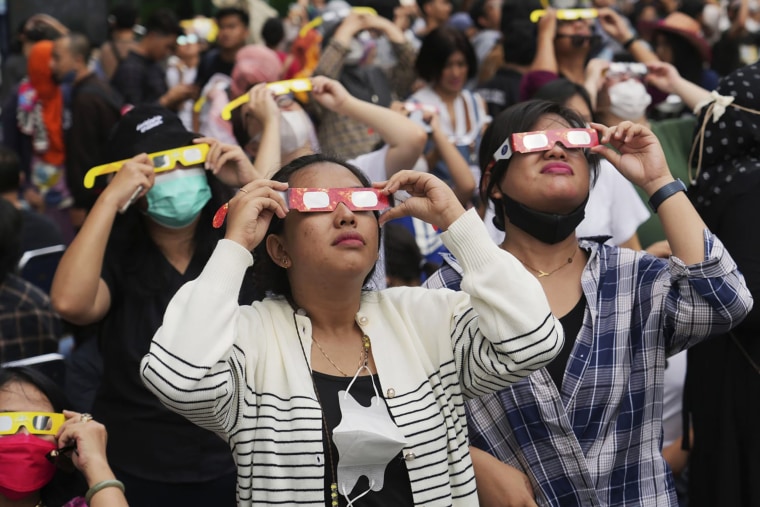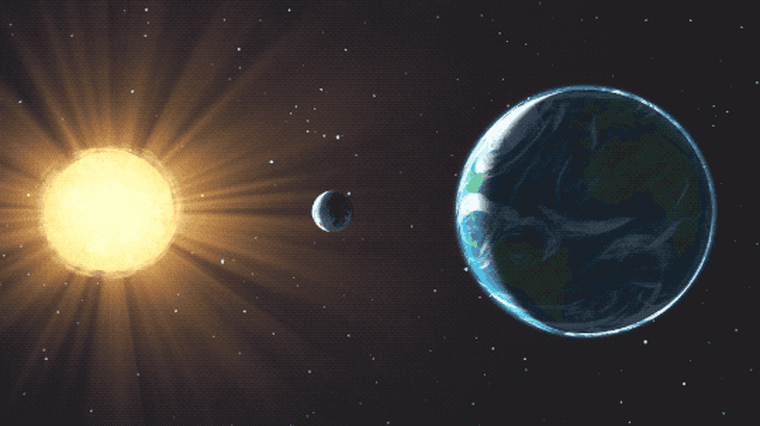Read NBC News' updated guide to the April 8 total solar eclipse here.
A total solar eclipse will cross North America in April, offering millions of sky-watchers a rare opportunity to see afternoon skies temporarily darken and an illuminated halo appear overhead.
The eclipse on April 8 promises to be a major event because its path fortuitously cuts across Mexico, the continental U.S. and a small part of eastern Canada. In the U.S., weather permitting, sky-watchers in 15 states will have the chance to see the moon almost completely cover the sun, casting its shadow over the fiery orb and creating the effect of a ring in the sky.
Tune into NBC News NOW as Lester Holt hosts a two-hour special at 2 p.m. ET Monday from Indianapolis Motor Speedway.

In all other states in the continental U.S., viewers will be treated to a partial solar eclipse, with the moon appearing to take a “bite” out of the sun and obscuring only part of it in the sky.
Here's everything you need to know about the coming total solar eclipse.
How to safely view a solar eclipse
People should never gaze directly at the sun during a solar eclipse, even when it is partly or mostly covered by the moon. Special eclipse glasses or pinhole projectors are required to safely view solar eclipses and prevent eye damage.
Sky-watchers should never view any part of the sun through binoculars, telescopes or camera lenses without specific solar filters attached to them. Eclipse glasses should not be used with them. Failing to take the proper precautions will result in severe eye injury, according to NASA.
During the few minutes of totality, when the moon is fully blocking the sun, it is safe to look at the total solar eclipse with the naked eye, but eclipse glasses should be used at all other times to look at the sun.
What is a solar eclipse?
Solar eclipses are essentially cosmic confluences, occurring when the sun, the moon and Earth align. The moon passes in front of the sun, temporarily blocking its light.
The moon can fully obscure the sun, as is the case with total solar eclipses, or it can block only a part of the sun’s light, as happens with partial solar eclipses.

Who will be able to see it?
The eclipse is rare because it will follow a slightly wider path over more populated areas of the continental U.S. compared to other total solar eclipses in recent memory.
NASA estimates that 31.6 million people live within the roughly 100-mile-wide path of totality this year and that an additional 150 million people live within 200 miles of the path.
After it crosses Mexico, the eclipse’s path will travel through Texas, Oklahoma, Arkansas, Missouri, Illinois, Kentucky, Indiana, Ohio, Pennsylvania, New York, Vermont, New Hampshire and Maine. Tiny parts of Michigan and Tennessee will also be able to witness totality if conditions are clear.
After it makes its way through the U.S., the eclipse will cross into Canada, passing over southern Ontario, Quebec, New Brunswick, Prince Edward Island and Cape Breton, at the eastern end of Nova Scotia.
The most spectacular views will require being within the path of totality, but people coast to coast still have the opportunity to take part in the astronomical event. A partial solar eclipse will be visible throughout all 48 states of the contiguous U.S., and NASA (along with several other organizations) plans to stream live views of the total solar eclipse online.
When will it happen?
The timing, including the length of totality, will vary depending on location, but some spots will experience darkness and see the moon fully covering the sun for up to 4 minutes and 28 seconds.
Below is a list of timings for some populated cities along the path of totality, as provided by NASA, but there are a number of other resources online, including at NationalEclipse.com and TimeandDate.com, to help people plan where to be and what to expect on the day.
Dallas: Partial eclipse begins at 12:23 p.m. CT; totality begins at 1:40 p.m. CT; totality ends at 1:44 p.m. CT; partial eclipse ends at 3:02 p.m. CT.
Little Rock, Arkansas: Partial eclipse begins at 12:33 p.m. CT; totality begins at 1:51 p.m. CT; totality ends at 1:54 p.m. CT; partial eclipse ends at 3:11 p.m. CT.
Cleveland: Partial eclipse begins at 1:59 p.m. ET; totality begins at 3:13 p.m. ET; totality ends at 3:17 p.m. ET; partial eclipse ends at 4:29 p.m. ET.
Buffalo, New York: Partial eclipse begins at 2:04 p.m. ET; totality begins at 3:18 p.m. ET; totality ends at 3:22 p.m. ET; partial eclipse ends at 4:32 p.m. ET.
Lancaster, New Hampshire: Partial eclipse begins at 2:16 p.m. ET; totality begins at 3:27 p.m. ET; totality ends at 3:30 p.m. ET; partial eclipse ends at 4:38 p.m. ET.
